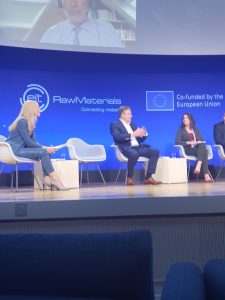Verde Magnesium is leading the EU prioritization of its critical magnesium supply with our Chairman, Dr. Bernd Martens, speaking at the EIT Raw Materials summit in Berlin highlighting how EU supply chains have become too long, too complex, and too fragile.
Securing magnesium is an EU priority: EIT Summit
Securing stable magnesium supply has become a priority for policymakers after an acute shortage of material in late 2021, panellists said at the EIT Raw Materials Summit in Berlin last week.
“To avoid disruptions, we need to be proactive. The best-case scenario is that we solve this problem through a combination [of production] in Europe and other countries in the world. This is a particular challenge given the energy price at the moment, but if we do not act, this shortage could happen on regular basis,” said Martin Tauber, European representative from International Magnesium Association.
The EU depends heavily on China, which supplies about 90pc of magnesium to the bloc, with small amount coming from countries such as Israel and Turkey.
To prevent another shortage, the European Commission is preparing a legislative proposal that includes plans to restart the production of magnesium in countries such as Romania and Bosnia, while the metal could be also recovered from mining waste deposits in Spain and Finland, said Joaquim Nunes de Almeida, directorate-general for internal market, industry and entrepreneurship at the European Commission. “In the case of magnesium and other industries, such as magnets, the commission will reinforce the value chain while at the same time ensuring a high level of environmental protection,” he said.
Consumers are also part of the conversation as the scarcity that took place in November that pushed prices to record highs caused concern at aluminium smelters and die-casters in Europe. In fact, European trade groups warned of the potentially “catastrophic” effects of a magnesium supply shortage on metals producers.
At the same time, to fast-forward production in Europe, aluminium producers could be more involved in offtakes in the future, delegates heard.
“We need support from end-users that should be part of offtake agreements early on,” said Verde Magnesium’s chairman, Bernd Martens. Romania-focused Verde Magnesium is striving to establish the EU’s sole primary supply source for the metal, which it says could meet 45-50pc of the continent’s demand. The project could start production within four years of approval, Martens said.
For their part, aluminium producers said they would potentially pay a premium to guarantee a stable supply in Europe. “Nearly half of magnesium demand comes from automotive. There is a clear interest in having a stable supply. Diversification is our priority, but also [it has to be] sustainable,” said Sigrid de Vries, secretary general at the European Association of Automotive Suppliers. “If they produce at a lower CO2, that would change the game.”
Taking into consideration the interconnectivity between different sectors should also be key for any legislative proposal. “The EU needs to look at the whole ecosystem, connecting sectors. It is a chain reaction. The shortage of magnesium puts automakers at risk,” de Vries said.
But changes are needed to help move projects, including forward mechanisms to prevent lower-cost international material being dumped in the EU. “We need a much more robust trade policy, particularly towards China, or we could face another shortage,” said Ines Inès Van Lierde, secretary general at industry association Euroalliages, who called for strict anti-dumping duties with China to make domestic production viable in Europe. The fear of dumping looms large over the region’s magnesium industry, after dumped Chinese material caused the closure of Europe’s last magnesium production site in France in 2001.
By Cristina Belda

